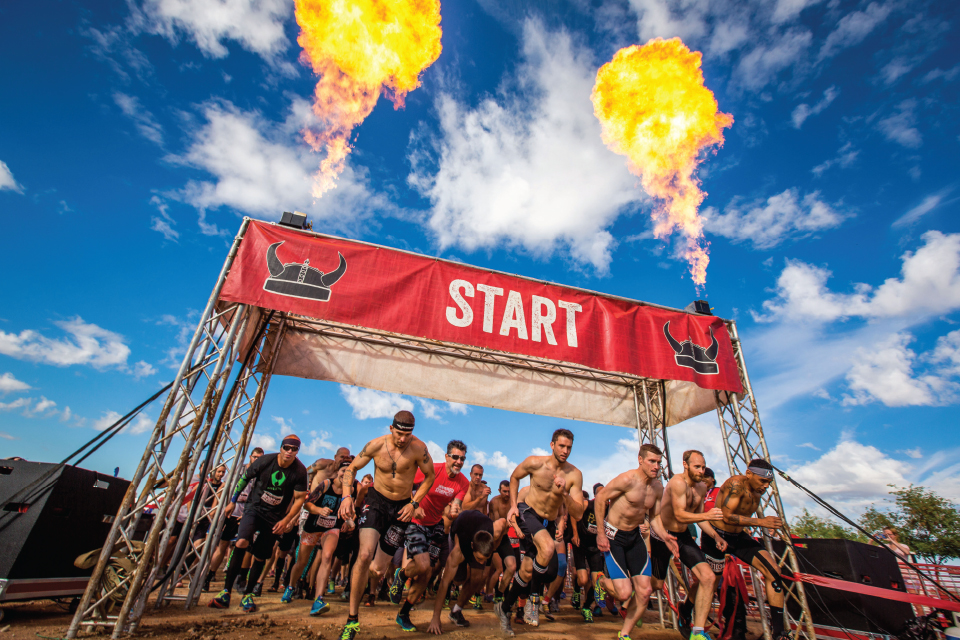Obstacle Course Racing


The Warrior Dash
Climb a 9-foot wall, carry a bucket of rocks up a hill, crawl under a barbed wire fence, leap frog over logs.
This could sound like your worst nightmare. But for many, these obstacles are just par for the course—literally. Obstacle Course Racing, typically abbreviated as OCR, is more than just a road race; it’s a community of likeminded people using their bodies and minds to overcome obstacles on the course and in their lives. They give you the power to rethink your own strength and your own possibilities. As an avid OCR racer, I see it all the time. People are finding more than just muddy sneakers on the racecourse; they are finding a new belief in themselves and taking that into their lives and families and jobs, to live better and be better. It’s a chain reaction. “Come on down, train your body, test your limits, make friends, get muddy” they say, and then, poof, you start to notice your whole life is changing.
OCR is often called the fastest growing sport in history. With roots in 1987 England, obstacle courses officially came to the U.S. about 20 years later with the creation of the Tough Mudder, a program that boasted a “non-race” approach to obstacle course running. Soon after, although with years of organizing unofficial obstacle courses under his belt, Joe De Sena founded the Spartan Race. With the addition of the Spartan Race, it seemed there was no stopping the OCR trend. The Warrior Dash was soon to follow with its less strenuous and more friendly type of race. Known as The Big Three, these powerhouse OCR programs have inspired smaller races to pop up all over the country. There really is a race for everyone and every level of fitness. However, a little research is necessary to decide which race is right for you.
While a quick Google search will give you tons of OCR options, not all are created equal. Looking to push your mental and physical limitations and experience a real adrenaline rush? You must get yourself to a Spartan Race! It’s accessible to all levels of athletes with its mileage options, but every race will test you in some unexpected way. Since most Spartan races take place on mountains at actual ski resorts, the terrain itself is a test. On the other hand, Tough Mudder offers the ability to take on challenges in a more fun, team-spirited way with unique obstacles that will test your endurance and mental fortitude. It also offers its own level of crazy with a 24-hour race called “The World’s Toughest Mudder.”
But the crazy doesn’t stop there—if Spartan founder Joe De Sena has his way, OCR has the potential to be an Olympic event in 2020. Certain races already have elite athletes making significant money and appearing as special guests, giving the sport an element of fame. But you don’t have to have Olympic aspirations or dreams of fame to join the World of OCR.
Keep reading for some of the toughest obstacles!

The Spartan Race
Pete’s Top 5 Obstacles
1. Bucket Carry (Spartan Race)
Fill a bucket with gravel and hike up and down what is sometimes the steepest part of the course.
2. Spear Throw (Spartan Race)
Also known as “the burpee maker” and “the race killer” because this deceptively simple obstacle has you throwing a spear into a target of hay 20 or so feet away, but if you miss you will suffer the 30 burpee penalty.
3. Wall Climbs (All Races)
Ranging from 5 to 9 feet tall, and built at different angles, wall climbs are a staple in OCR.
4. Monkey Bars/Platinum Rig/Multi-rig (All Races)
This is the ultimate in monkey bar technology. Challenging grip with bars, rings, ropes, baseballs, inclines, and declines.
5. Barbed Wire Crawl (Spartan Race)
Ranging in length, the barbed wire crawl has racers squirming through mud, tree stumps, rocks, and water trying to get to the finish line.
Bonus
Most Spartan Races are on a ski mountain, so the terrain is obstacle enough!
Racing offers a sense of reinvigoration and a way to break up the monotony of everyday life. Being in an office isn’t so bad when you’re still running off adrenaline from finally nailing that rope climb. The sense of competition, strength, grit, determination, endurance, and satisfaction in completing an OCR is indescribable. Life can become average and boring, but we live for the feeling of getting outside the mundane and achieving things we didn’t think possible.
Luckily, the Spartan offers seven levels of courses, so you can ease into testing your limits.
Level 1: The Stadium Sprint is about 3 easy miles with 20-25 obstacles
Level 2: The Standard Sprint is 3 to 4.5 not-so-easy miles and 20+ obstacles
Level 3: The Super is 8 to 10 miles with 25+ obstacles
Level 4: The Beast is 13 to 15 miles with 30+ obstacles
Level 5: The Ultra Beast is TWO laps of the Beast course—you do the math
Level 6: The Hurricane Heat, a 12-hour race event
Level 7: The Agoge, Spartan’s newest race, featuring a 60-hour course
Regardless of the choice you make, each level will push you mentally and physically, and I promise you’ll be coming back for more






